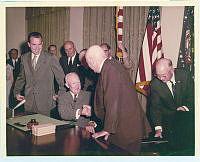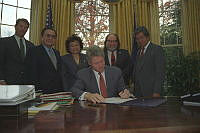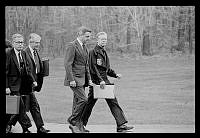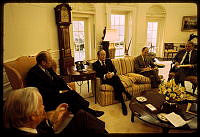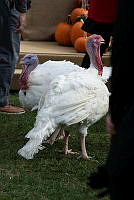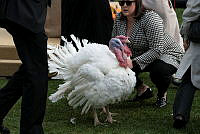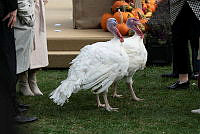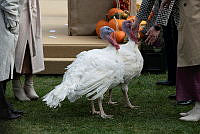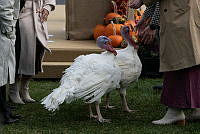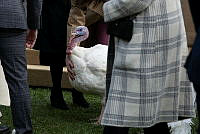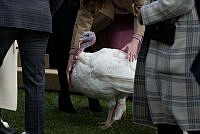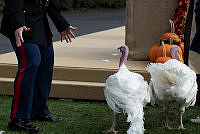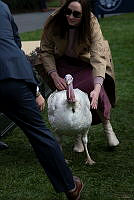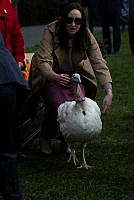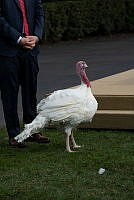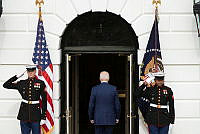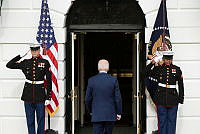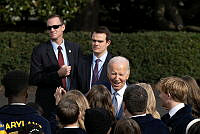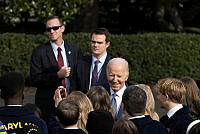Rubenstein Center Scholarship
Second Spouses
Historical Development of an Official Role
For much of American history, the spouse of the Vice President of the United States did not maintain a prominent public role. However, as the Office of Vice President has evolved over time to include more responsibilities, power, influence, and resources, the “Second Spouse” has also grown in recognition and stature.
One notable historical exception is Floride Calhoun, the wife of Vice President John C. Calhoun, who occupied the office from 1825 to 1832 under two presidents, John Quincy Adams and Andrew Jackson. During the latter’s presidency, Floride Calhoun led a group of Cabinet wives who ridiculed Margaret Eaton, the wife of the Secretary of War John Eaton. This episode became known popularly as the “Petticoat Affair.” Floride Calhoun and her accomplices believed Margaret Eaton was a woman of low morals who had committed adultery. According to the gendered moral code of the time, Eaton was unfit for polite society, including social gatherings in Washington, D.C. Floride Calhoun served as the unofficial leader in the persecution of Margaret Eaton. This led to dissension within Andrew Jackson’s cabinet. Since Jackson himself strongly supported the Eatons, an estrangement developed between Jackson and Calhoun, eventually resulting in the resignation of the vice president. Martin Van Buren served as Andrew Jackson’s vice president during his second presidential term.1

Portrait of Floride Bonneau Colhoun Calhoun by Eugene DeBlock
Fort Hill European Art CollectionThe term “Second Lady,” the honorific used to designate the wife of the vice president, was first used publicly years after the inception of the title “First Lady,” which began with Frances Folsom Cleveland in 1886. Jennie Hobart, the spouse of Vice President Garret Hobart (1897-1899), called herself “Second Lady” when she assumed the hostess duties typically performed by the First Lady of the United States. Ida McKinley, who was married to President William McKinley, suffered from epilepsy and other chronic ailments, which made it impossible for her to host receptions or greet guests at the White House.2
Jennie Hobart and her husband lived in a house on Lafayette Square which came to be known as the “Little Cream White House.” Located at 21 Lafayette Square, it was formally the Benjamin Ogle Tayloe House, constructed in 1828. As vice president, Garret Hobart became a trusted adviser and confidante of President McKinley. In some regards their relationship was similar to that of Martin Van Buren and Andrew Jackson, but much had changed since the 1830s. With the growth of the federal government in size and complexity, as well as the emergence of the United States on the world stage during the Spanish-American War, Hobart made “historically significant expansions of vice-presidential power” during his time in office. Most notably, Hobart viewed the office as a source of influence and power rather than serving a primarily ceremonial function.3
Likewise, Jennie Hobart and Ida McKinley grew close, and their mutual friendship led to Hobart’s willingness to assume the traditional hostess duties of the First Lady. Later in life, Jennie Hobart wrote that she did this, “Not because I was Second Lady, but because I was their good friend.”4
The public role of the second lady did not expand throughout the first half of the twentieth century. The only institutional role for the spouse of the vice president was to serve as the unofficial convener of the Red Cross Senate Wives, an organization formed in 1917 to aid American efforts during World War I. The second lady typically presided over the lunches hosted by the group, which consisted of the wives of United States senators. The group evolved to the current “Senate Spouses” club when women began serving elected terms in the Senate.5

Jennie Tuttle Hobart
David Magie, The Life of Garret Augustus Hobart (1910)Patricia Nixon began the transformation of the role of second lady during the Dwight Eisenhower administration when her husband Richard Nixon served as vice president (1953-1961). Mrs. Nixon traveled independently of the vice president, set her own schedule, and attended events without her husband. She often visited hospitals, orphanages, and other local community organizations during her travels.6
Muriel Humphrey fulfilled the role of second lady when her husband, Hubert Humphrey, served as vice president during Lyndon Johnson’s full elected term of office (1965-1969). The Wall Street Journal described Muriel Humphrey as one of the vice president’s “key advisers.”7 She traveled extensively on official visits as Second Lady of the United States. After serving as vice president, Hubert Humphrey was elected to the United States Senate from Minnesota. Upon his death in 1978, the governor appointed Muriel Humphrey to serve the last year of her husband’s term. As a senator, she advocated for an extension of the ratification date for the Equal Rights Amendment.8 She is the only second spouse to serve in federal office.
Betty Ford followed in Muriel Humphrey and Pat Nixon’s footsteps by further enhancing the public profile of the role. Mrs. Ford served as second lady when her husband, Gerald Ford, was vice president (1973-1974). As second lady, Mrs. Ford gave several media interviews in which she provided her opinions on controversial topics such as abortion, pre-marital sex, and marijuana use.9 Departing from convention, these interviews generated considerable attention. Ford claimed she approached her positions as first lady and second lady with honesty and candor.

Muriel Humphrey was the only second spouse to serve in Congress.
United States SenateIn 1977, President Carter named Joan Mondale, wife of Vice President Walter Mondale, as the honorary chairperson of the Federal Council on the Arts and Humanities; she served as the Carter administration’s “ombudsman for the arts.”10 As second lady, she also transformed the vice president’s residence at the Naval Observatory, making it a showcase for American contemporary art. For her strong support in this area, she was known as “Joan of Art.”11
In 1978, federal statute was changed to authorize budgetary support for the spouse of the vice president. Such funding can be expended if it is used “in the discharge of the Vice President’s executive duties and responsibilities.” In the event that the vice president does not have a spouse, support may be provided for such purposes to a member of the vice president’s family whom the vice president designates.12
During the 1980s, the second spouse became an established, key component of the vice president’s team. The office of the second spouse is located in the Eisenhower Executive Office Building (EEOB) on the second floor, adjacent to the office of the vice president. The second spouse has previously employed three staff members: a chief of staff, communications director, and policy aide.13 The acronym associated with the female spouse of the vice president is SLOTUS (Second Lady of the United States), while the acronym for a male spouse of the Vice President is SGOTUS (Second Gentleman of the United States).

Joan Mondale playing drums at the National Museum of African Art, 1978.
Smithsonian Institution ArchivesRecent second ladies have increased and expanded the role of the office. Barbara Bush hosted 1,192 events and traveled 1.3 million miles during her eight years in the position.14 Tipper Gore, who self-identified as a “volunteer” in the Office of Vice President rather than second lady, served as a mental health adviser for First Lady Hillary Clinton’s task force on health care. Testifying about mental health issues, Gore became the first second spouse to speak before a congressional committee.15
The first second spouse to hold a doctorate, Dr. Lynne Cheney published numerous children’s books and a book about the United States Constitution during the years her husband served as vice president. She also continued to work as a research fellow at the American Enterprise Institute, a think tank in Washington, D.C.16 Dr. Jill Biden continued this trend, working at Northern Virginia Community College as an English professor during her husband’s tenure as vice president. She promoted the cause of military families and breast cancer awareness as second lady.17 Finally, Karen Pence promoted the use of art therapy in the mental health profession as second lady. Like Dr. Biden, Mrs. Pence worked as a teacher while serving in her public role.18
Doug Emhoff, the husband of Vice President Kamala Harris, is the first man to assume the role of second spouse. Mr. Emhoff teaches law at Georgetown University while serving in support of the Vice President of the United States. Over time, the role of second spouse will continue to evolve and transform as incumbents of the office challenge traditions and previously accepted practices.













